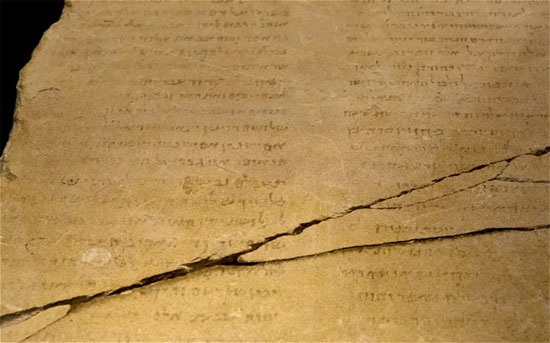Gabriel's mysterious stone
An ancient limestone slab containing ancient Jewish texts was displayed in Jerusalem, while scholars continued to debate its content.
Known as the "Gabriel Stone" , according to the archangel of Christianity, a 1m high stone table was found 13 years ago at the Dead Sea, with 87 lines of mysterious characters on his face. Most likely this stone tablet dates back to the first century BC, during the second Jewish Temple. Scholars argue that if they decode them, they will open the door to discover religious ideas that prevailed in the holy land at the birth of Jesus.
Grabiel stone is special in that the words are printed in ink, not on stone. And no religious texts have ever been discovered in the area. Experts from the Israel Museum, which hosts the above stone display, said it was the most important document ever found in the area, since the discovery of the tremors of the Dead Sea scrolls.'Gabriel Stone is like a Dead Sea scroll written directly on the stone' , according to Director of the Israeli Museum James Snyder. These two documents were written at the same time, and shared the ancient Jewish writing art.

The stone remains with only a few vague words - (Photo: Telegraph.co.uk)
Stone Gabriel created a real seismic in archeology in 2008, when an Israeli Bible scholar Knohl made a bold hypothesis that the slab handwriting could make a way The network of early Christians. He also boldly proclaimed the unspoken words on the concept of the resurrection of a savior before Jesus. Knohl draws this conclusion based on a short paragraph on the slate that experts are lucky to translate, meaning 'in 3 days he will live' . If so, the story of Easter after being executed on the cross is no longer ' Christian ' .
Needless to say how this interpretation created a great storm in the world of Bible researchers, making world scholars hold a global conference a year later to debate the content. of ancient documents, drawing the attention of a documentary team from National Geographic. A group of American experts also joined. They used all the most modern methods to decipher the content of the manuscript that had faded in stone, but ultimately failed. Dr. Knohl later withdrew the original concussion hypothesis, but the controversy that he sparked was not so cool.
Scholars continue to argue over the true content of the texts on the slate, while kicking Gabriel to begin his journey with other relics to Rome, Houston and Dallas. So far, the famous stone research work has not flourished, partly because the letters were lost in the key lines, and on the surface of the slab appeared two crisscross lines, dividing it into 3 Piece. Only about 40% of 87 lines are readable, and experts have interpreted 5 paragraphs. However, everyone agrees that the content of the piece is displayed at the Israel Museum about the prospect of the apocalypse when Jerusalem was attacked, and God appeared with the archangels on the chariots. to save the city. The key figure in the archangels is Gabriel. Therefore, this stone was named Gabriel stone.
However, it is unlikely that the above solutions are correct. Since being excavated in 2000, the stone tablet has always resisted all efforts of exploration of experts, and has been called the "real life story of the Da Vinci Code" by the media.
- The solution to the mystery of the strange
- Detecting mysterious stone statues in China
- The mysterious glowing stone in the night in Dong Nai
- Discover the mysterious stone on Mars
- Mysterious structure under the Israeli sea
- The mysterious ancient stone circles in the Middle East
- Hundreds of strange stone circles in Martian Son
- Egypt opened the lid of ancient stone coffin 2,000 years
- Mysterious stone glows, radiates strange gas in Mexico
- Mysterious stone statues of prehistoric stone in France
- Mysterious universe hidden in natural gems
- Amazingly the stone itself grew, bulging
 The truth about the mysterious red-haired giant at Lovelock Cave
The truth about the mysterious red-haired giant at Lovelock Cave Inunaki Tunnel: The haunted road leading into Japan's 'village of death'
Inunaki Tunnel: The haunted road leading into Japan's 'village of death' The mystery of the phenomenon of human reflection before dying
The mystery of the phenomenon of human reflection before dying 6 mysterious phenomena, although science has been developed for a long time, still cannot be answered
6 mysterious phenomena, although science has been developed for a long time, still cannot be answered